Research Abstract
三次元腫瘍の全組織生検表現型解析ががん不均一性のパターンを明らかにする
Whole-tissue biopsy phenotyping of three-dimensional tumours reveals patterns of cancer heterogeneity
2017年10月2日 Nature Biomedical Engineering 1 : 796 doi: 10.1038/s41551-017-0139-0

腫瘍内不均一性は、がん患者の診断および治療にきわめて重要な要素である。ゲノム塩基配列解読法の進歩により、がん細胞の遺伝的およびエピジェネティックな背景の著明な差が明らかにされてきたが、充実性腫瘍の腫瘍内不均一性の表現型状況および空間的分布はほとんど知られていない。今回我々は、上皮間葉転換および血管形成に関して、完全なホルマリン固定パラフィン包埋(FFPE)生検標本の表現型不均一性の固有パターンが、透明化した充実性腫瘍の三次元光シート顕微鏡法によって1細胞の分解能で明らかにされることを示した。また、検査後の透明化FFPE標本が将来の使用のためにパラフィン再包埋可能であることが示されるとともに、我々の腫瘍表現型解析パイプラインにより、臨床検体からの腫瘍ステージ判定および患者予後分類が従来の診断法を上回る正確度で行われ、効率の高いがん治療法の設計が促進されることも明らかになった。
Corresponding Author
Intratumoral heterogeneity is a critical factor when diagnosing and treating patients with cancer. Marked differences in the genetic and epigenetic backgrounds of cancer cells have been revealed by advances in genome sequencing, yet little is known about the phenotypic landscape and the spatial distribution of intratumoral heterogeneity within solid tumours. Here, we show that three-dimensional light-sheet microscopy of cleared solid tumours can identify unique patterns of phenotypic heterogeneity, in the epithelial-to-mesenchymal transition and in angiogenesis, at single-cell resolution in whole formalin-fixed paraffin-embedded (FFPE) biopsy samples. We also show that cleared FFPE samples can be re-embedded in paraffin after examination for future use, and that our tumour-phenotyping pipeline can determine tumour stage and stratify patient prognosis from clinical samples with higher accuracy than current diagnostic methods, thus facilitating the design of more efficient cancer therapies.

